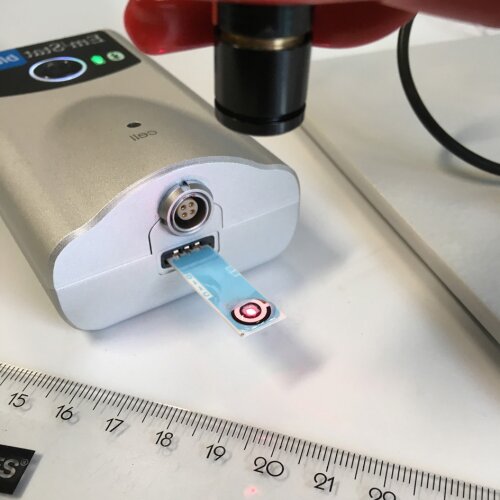Biosensors, singlet oxygen based detection of phenolic compounds
The University of Antwerp has developed a new sensing technique to detect phenolic compounds in water streams on bases of photocatalysis and electrochemical detection. The sensors have a very low detection limit (0.012 μM for 8-hydroxyquinoline) and fast response time (< 10 s). The sensors are a fast and robust alternative for COD measurements used today for phenolic compounds.

Situation before
Over the last three decades several research groups have advanced the electrochemical detection of phenols at Horse Radish Peroxidase (HRP) modified electrodes as well as the use of HRP and alkaline phosphatase as enzyme labels in electrochemical immunoassays. The market penetration and use of electrochemical biosensors, however, remains low due to a number of drawbacks. The production of enzymes is expensive and inherently shows significant lot-to-lot variation. Often immobilization procedures are complex and costly, moreover enzymes are vulnerable to denaturation and have relatively short expiration periods. The assays themselves are not well suited for field use as extra reagents are required, some of which exhibiting low stability (e.g. H2O2).
Technology
The Antwerp X-ray analysis, Electrochemistry and Speciation Group (AXES) of prof. K. De Wael in collaboration with prof. S.M. Gorun of Seton Hall University (US) developed a new technology based on the reliability of photo-electrochemical detection and the principles of enzyme detection, that is, catalytic signal amplification, but translated into a bioinspired catalyst that needs only air and light to function. The sensor uses a molecular photosensitizer which, under visible light illumination (e.g. Diode laser, 655 nm, 30 mW) generates reactive singlet delta oxygen, 1O2, which, in turn triggers the appearance of a photocurrent due to its, or its daughter species (Reactive Oxygen Species) reactions with analytes such as 8-hydroxyquinoline.
Amoxicillin, a b-lactam antibiotic containing a phenolic moiety was used to test the efficiency of the proposed detection strategy and showed to have a detection limit (LOD) as low as 22 nM, even in the presence of other oxidizing or reducing species.
About the researchers
Since 2011, Prof. Karolien De Wael became appointed as tenure track assistant professor at the Department of Chemistry, University of Antwerp, in 2016 she was promoted to associate professor with a research focus. Her main research interests are related to analytical chemistry, electrochemistry and (bio)sensor development. From 2012 she organizes the annual SMOBE meetings (summer meeting on bio-electrochemistry), organized in Antwerp. She is involved as supervisor or co-supervisor in numerous projects on (bio)electrochemistry aiming the detection of target molecules. In total 7 PhDs were successfully defended in the past five years with K. De Wael as (co)promotor. Since 2014, she is member of the Young Academy (Belgium). From 2016, she is vice chair of the Chemistry Department and from 2017 she is member of the Industrial Research Fund (IOF) at the University of Antwerp. Over the last few years the AXES research group has grown and now counts ca 25 members. She is currently supervising 12 PhDs as (co)promotor.
The AXES research group is part of the Chemistry Department and performs fundamental, metho-dological and application-oriented research involving a wide range of analytical techniques. A recurring theme in our research is the use of state-of-the-art methods for determination of low concentration levels and/or for imaging of (one or multiple) analyte species. These methods are frequently (but not exclusively) applied to address environmental problems.
More information
University of Antwerp
Valorisation Office
Middelheimlaan 1
2020 Antwerpen - Belgium